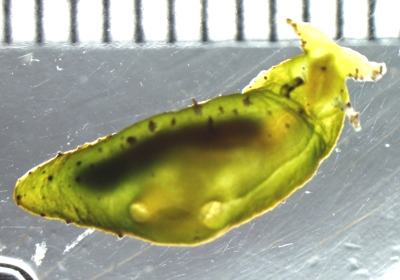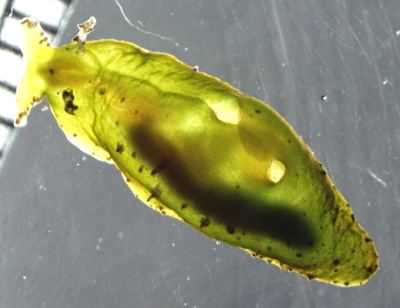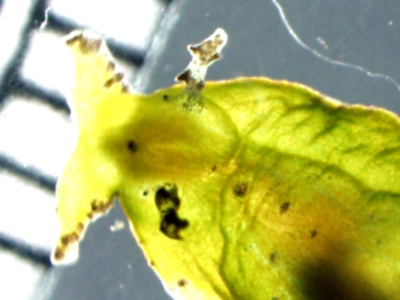Phyllaplysia smaragda or P. engeli from Florida
July 8, 2008
From: Geoffrey Smith Jr.


Dear Bill
This is another sea slug I have found several times over the past few years in Sarasota, Florida. It is semitransparent and light green in color, and an inch or less in length. All of the specimens I have collected were in dip nets being pushed across shallow seagrass beds consisting mainly of Thallasia testudinum and Syringodium filiforme. I believe it may be a species of Phyllaplysia.
Locality: New Pass in Sarasota, 2-5 feet, Florida, United States, Gulf of Mexico, several time in 2007 and 2008, seagrass bed. Length: an inch or less (1 mm increments on scale bar in pics). Photographer: Geoffrey Smith.
Geoff
geoffreyhsmith@gmail.com
Smith, G.H., 2008 (Jul 8) Phyllaplysia smaragda or P. engeli from Florida. [Message in] Sea Slug Forum. Australian Museum, Sydney. Available from http://www.seaslugforum.net/find/21684
Dear Geoff,
I would agree that this is a species of Phyllaplysia but I have a problem with identifying it to species. Two species, P. engeli and P. smaragda have been reported from the Caribbean and they are reported to have some anatomical differences, but I doubt if enough specimens have been studied to determine whether these differences are inter or intra-specific in importance, or even based on distorsions during preservation. For example P. engeli has a crop between the buccal bulb and gizzard while P. smaragda doesn't and P. smaragda is said to have fewer spines on the penis. In external shape P. smaragda is said to be more elongate and have the oral tentacles joined at the base while in P. engeli the oral tentacles are said to be more separate and the body shorter and rounder, which are both variable characters dependent on whether the animal is extended crawling or sitting at rest.
Colour is very difficult to use as a character in these animals because it is variable and can be affected by the colour of the plant material being eaten. Kerry Clark observed green P. smaragda going reddish-brown after a few weeks in an aquarium feeding on reddish algal growths on the aquarium wall (Clark, 1977).
The uniform green colouration of your animals, and their blackish papillae don't fit the colour information we have on either of the Caribbean species, but I suspect it is just the normal colour variation of one species. Since the earliest name is P. engeli, that is the one I will use until a more comprehensive study on anatomical and colour variability is undertaken. Kerry Clark reported P. smaragda living on Syringodium and concluded its diet consisted of Erythrocladia subintegra, which lives on Syringodium, and scrapings of Syringodium, but as I mention above, it also in aquarium conditions can feed on other algae.
-
Clark, K.B. (1977) Phyllaplysia smaragda (Opisthobranchia: Notarchidae), a new anaspidean from Florida. Bulletin of Marine Science, 27(4): 651-657.
Bill Rudman Rudman, W.B., 2008 (Jul 8). Comment on Phyllaplysia smaragda or P. engeli from Florida by Geoffrey Smith Jr.. [Message in] Sea Slug Forum. Australian Museum, Sydney. Available from http://www.seaslugforum.net/find/21684
Related messages
-
Re: Phyllaplysia smaragda or P. engeli from Florida
From: Geoffrey Smith, July 9, 2008 -
Phyllaplysia engeli from Florida
From: William Schill, January 29, 2005 -
Phyllaplysia from Tampa Bay, Florida
From: Nicholas Curtis, January 14, 2004
